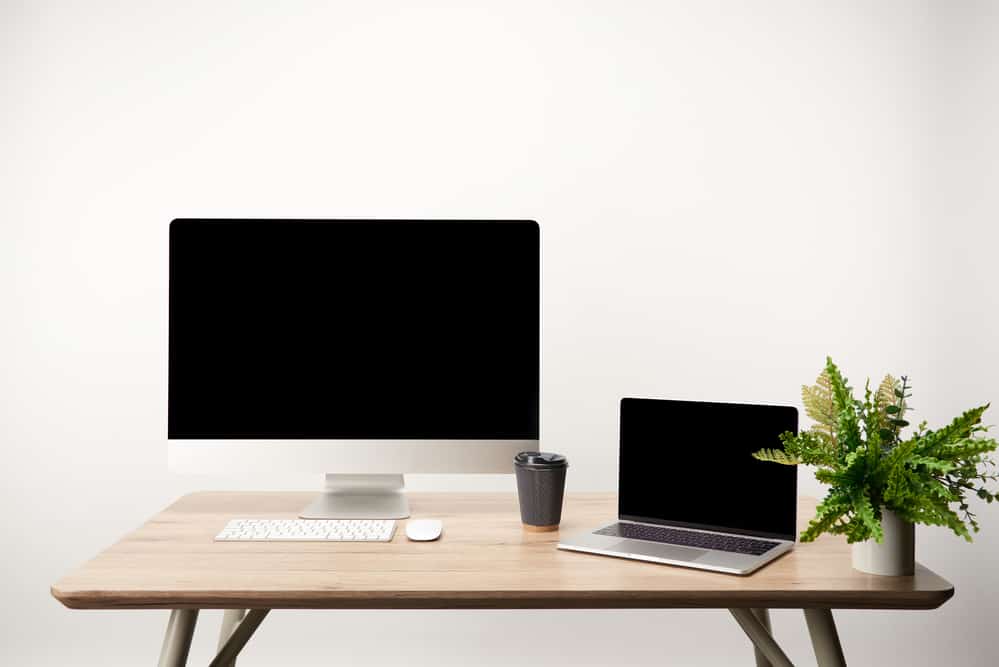
Desktops and laptops have become integral parts of our lives.
We perform almost every important task with them, including work, school, shopping, watching movies, gaming, video and photo editing, and so on.
At some point, anyone could ask themselves just how much energy these capable machines use and how much it costs to run them.
How To Measure The Computer’s Power Consumption (5 Methods)

There are various models of desktops, laptops, and Chromebooks are available, each with different components that come from different brands.
Some people attach speakers, modems, printers, and other devices to their computers.
Some people have multiple monitors.
Overall, the best method for determining your computer’s power consumption is to measure it yourself.
Here are different methods to test.
1. Local Cooling
Local Cooling is a free utility that can estimate the main computer component’s power usage.
After you’ve downloaded and installed the app, click on the Settings button and head to the My Power tab.
The app can also help you manage your power settings.
2. Power Supply Calculator
The Power Supply Calculator is a great online tool for estimating your power budget for free.
It can’t calculate your system’s power usage in real-time, but it allows you to choose the PC component brands and their models, so you can get the ballpark figure.
This will also be an excellent tool for those who want to build their own computer systems and want to know how much energy each part will use up.
3. OuterVision
The OuterVision calculator is a highly detailed tool that even PC hardware and power supply manufacturers use.
This basic calculator allows a quick estimation of the computer’s power draw.
You should know the details about your computer’s components.
You’ll enter the model of the monitor, optical drive, storage, graphics card, RAM, CPU, and motherboard.
Then you’ll enter the number of hours you use your computer, and it’ll give you the general power consumption.
The Expert OuterVision calculator goes a bit further for advanced users and lets you add in the fans, liquid cooling kits and pumps, CPU utilization, PCI cards, Express cards, and multiple numbers of video cards.
It lets you calculate the power consumption of attached devices like keyboards, mice, controllers, USB devices, or LED systems.
There are even options for including the CPU and GPU overclocking.
4. Open Hardware Monitor
One of the most popular and lightweight applications for calculating the computer’s energy usage is the Open Hardware Monitor.
Once you install it, it collects data from monitor voltages, temperature sensors, fan speeds, load and clock speeds, and other parts to offer you real-time power draw readouts.
This app also provides other valuable information about your PC like the GPU, CPU, and hard drive temperature, fan and clock speeds, and so on.
5. Power Meter
Using a Power Meter or Watt Meter is the most accurate method for calculating the computer’s power draw within a very low margin of error.
These handy devices plug into the wall outlet, and then you should plug your computer onto them so that they can show you the real-time energy consumption.
The most popular power meter is the Kill-A-Watt Electricity Usage Monitor that’s easy to use and goes for around $20 or $30.
It works for all electronic devices that can be plugged into an outlet, so getting one will quickly help you find out which devices are the greedy energy consumers around your house.
This device doesn’t have many extra features; for instance, it can’t record the power consumption.
If you want a more advanced device, you can consider the HOBO UX120-018 Plug Load Data Logger with lots of additional capabilities.
It’s important to note that this unit does come at a much higher price, and the average user won’t benefit much from it.
How Much Money Are You Spending On The Electricity That Your Computer Consumes?

Now that you know how to measure your computer’s power usage, let’s calculate the cost of it for those who want to manage their budgets.
It’s a simple calculation process, but you need to know the average time you use the computer per day, and also how much electricity costs where you live.
For instance, let the power meter record your computer’s consumption for a week.
Then divide that number by seven to get the average daily usage.
Then find out the price you pay for electricity per kilowatt/hour.
In the United States, the average electricity cost is 13 cents per kilowatt-hour, but it varies from area to area.
Therefore, to get the exact price, either check your electric bill or check out the Global Electricity Prices.
If your city has tiered pricing for different times of day, use the average rate.
Lastly, multiply the average daily usage by the average electricity cost to get how much you pay for your computer’s power every day.
You can then multiply that by 30 to get monthly usage or by 365 to get the yearly use.
A more straightforward method is to enter the data you’ve collected to the Energy Use Calculator and let it do the hard work.
Generally, the costs for running your PC normally won’t take up much of the electric bill.
However, if you do cryptocurrency mining or overclock your system, it will run up the cost.
Using your computer at high power 24 hours a day, seven days a week can cost up to $50 per month.
How Much CO2 Does Your Computer’s Power Consumption Represent?

To give you an idea of roughly how much CO2 the computer or laptop’s power usage emits, let’s assume that a desktop uses 200 Watts per hour on average.
This number includes the connected printer, modem router, and loudspeakers.
If the computer works for eight hours a day, it emits 175 kg of CO2 every year.
A laptop uses less energy, around 50 and 100 Watts per hour.
A laptop that is on for eight hours daily emits between 44 kg and 88 kg of CO2 yearly.
If you put the desktop or laptop on standby mode, they consume one-third of the mentioned energy, and the CO2 emission decreases by about 15%.
Tips For Saving Energy

- Turn off Your Computer: Many people still believe that turning off the computer will wear it down faster. That’s just a myth! By cycling your computer a couple of times during the day, you won’t damage it at all. You’ll just save energy! Therefore, when you know you’ll be away from your computer for more than 30 minutes, simply shut it down.
- Put Your Computer to Sleep: A computer that’s in Sleep or Standby mode consumes much less energy than a running one. Nowadays, most laptops and computers automatically go to sleep when they’re inactive for a while. Firstly, make sure that you haven’t accidentally turned this feature off. Secondly, you can save more energy by tweaking the settings and setting the computer to sleep sooner, for instance, after 15 minutes of inactivity or less. You can also put it to sleep when you’re going away for a break instead of waiting for the automatic feature to kick in. To do even more, you can turn on the hibernate mode. This will save all your work but turn off the computer to save even more energy than the standby mode. In turn, it will take a bit longer to start up as well. Note that you’ll only save energy when the screen goes dark, so avoid using screensavers showing images and keeping the monitor running.
- Turn Off the Connected Devices: The printer, speakers, router, and any other device connected to the computer draw power from it unless you turn them off when you’re not using them. You can also get multiple sockets to turn off all the computer equipment with a single switch.
- Switch to Laptops: The decision to swap your desktop for a laptop depends on many factors, but you must know that laptops use much less energy than their desktop counterparts. If you need a desktop set for gaming or other activities, you can consider using a laptop for regular daily work.
Why Would You Want To Know Your PC’s Power Consumption?

You might be asking this question out of mere curiosity, but there are several valid reasons to know how much juice your primary productivity device uses.
Firstly, you might be facing a huge electric bill and are wondering about the expenses.
Knowing how much power your computer uses can help you with budgeting, especially if you have a huge gaming system or use your computer for intensive tasks like heavy video editing or programming.
Routine use of a computer won’t affect the energy bill very much.
The second scenario happens when you want to get your charger or power cord replaced.
It would be essential to know the actual wattage consumption to reach the maximum charging speed without damaging the system.
Lastly, you may want to upgrade your PC with extra high-performance components that can affect power consumption, and in turn, the electric bill.
For instance, high-end graphics cards can have a considerable effect on energy usage.
New processors usually need more power as well.
Before buying expensive components for your new upgrade, you need to calculate their power consumption because you might need to update your power supply first.
Moreover, updating the power supply and increasing the electricity will affect your home’s circuitry and the other components in your computer, so knowing the exact power requirements is vital.
What Factors Affect The Amount Of Power Your Computer Consumes?

Not every PC is the same, and therefore, every PC’s power consumption differs from the others, and here are the effective factors:
- The Computer’s Components: As mentioned before, the components inside your computer affect its power consumption. Top-of-the-line graphics cards and fast processors, multiple fans for the cooling system, and other factors will increase the energy bill.
- How You Use the Computer: If you have a beast of a desktop system, but you only use it for web browsing and word processing, it won’t consume more energy than a simple Chromebook. However, if you run intense gaming sessions for hours, mine coins, or perform any intensive task, the computer will consume more power. Also, if you put a computer in Sleep or Standby mode, it’ll need less electricity.
- Being Online: If your computer is connected to the internet, it’ll consume more energy than when you’re offline.
- Type of computer: The type of computer matters as well.
For instance, a Mac consumes less power than a PC.
Chromebooks are also much more energy efficient.
NEXT: PC Turns On But No Display (Causes, Fixes)

























